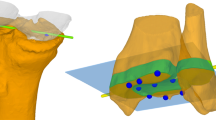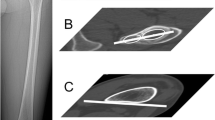Abstract
Objective
Various methods have been described to define the femoral neck and distal tibial axes based on a single CT image. The most popular are the Hernandez and Weiner methods for defining the femoral neck axis and the Jend, Ulm, and bimalleolar methods for defining the distal tibial axis. The purpose of this study was to calculate the intra- and interobserver reliability of the above methods and to determine intermethod differences.
Methods
Three physicians separately measured the rotational profile of 44 patients using CT examinations on two different occasions. The average age of patients was 36.3 ± 14.4 years, and there were 25 male and 19 female patients. After completing the first two sessions of measurements, one observer chose certain cuts at the levels of the femoral neck, femoral condylar area, tibial plateau, and distal tibia. The three physicians then repeated all measurements using these CT cuts.
Results
The greatest interclass correlation coefficients were achieved with the Hernandez (0.99 intra- and 0.93 interobserver correlations) and bimalleolar methods (0.99 intra- and 0.92 interobserver correlations) for measuring the femoral neck and distal tibia axes, respectively. A statistically significant decrease in the interobserver median absolute differences could be achieved through the use of predefined CT scans only for measurements of the femoral condylar axis and the distal tibial axis using the Ulm method. The bimalleolar axis method underestimated the tibial torsion angle by an average of 4.8° and 13° compared to the Ulm and Jend techniques, respectively.
Conclusions
The methods with the greatest inter- and intraobserver reliabilities were the Hernandez and bimalleolar methods for measuring femoral anteversion and tibial torsion, respectively. The high intermethod differences make it difficult to compare measurements made with different methods.






Similar content being viewed by others
References
Paley D, Herzenberg JE, Tetsworth K, McKie J, Bhave A. Deformity planning for frontal and sagittal plane corrective osteotomies. Orthop Clin North Am. 1994;25:425–65.
Paley D, Tetsworth K. Mechanical axis deviation of the lower limbs. Preoperative planning of multiapical frontal plane angular and bowing deformities of the femur and tibia. Clin Orthop Relat Res 1992:65–71.
Paley D, Tetsworth K. Mechanical axis deviation of the lower limbs. Preoperative planning of uniapical angular deformities of the tibia or femur. Clin Orthop Relat Res 1992:48–64.
Feldman DS, Henderson ER, Levine HB, et al. Interobserver and intraobserver reliability in lower-limb deformity correction measurements. J Pediatr Orthop. 2007;27:204–8.
Noyes FR, Goebel SX, West J. Opening wedge tibial osteotomy: the 3-triangle method to correct axial alignment and tibial slope. Am J Sports Med. 2005;33:378–87.
Jaarsma RL, Bruggeman AW, Pakvis DF, et al. Computed tomography determined femoral torsion is not accurate. Arch Orthop Trauma Surg. 2004;124:552–4.
Murphy SB, Simon SR, Kijewski PK, Wilkinson RH, Griscom NT. Femoral anteversion. J Bone Joint Surg Am. 1987;69:1169–76.
Sugano N, Noble PC, Kamaric E. A comparison of alternative methods of measuring femoral anteversion. J Comput Assist Tomogr. 1998;22:610–4.
Kuo TY, Skedros JG, Bloebaum RD. Measurement of femoral anteversion by biplane radiography and computed tomography imaging: comparison with an anatomic reference. Invest Radiol. 2003;38:221–9.
Bouchard R, Meeder PJ, Krug F, Libicher M. Evaluation of tibial torsion—comparison of clinical methods and computed tomography. Rofo. 2004;176:1278–84.
Hernandez RJ, Tachdjian MO, Poznanski AK, Dias LS. CT determination of femoral torsion. AJR Am J Roentgenol. 1981;137:97–101.
Weiner DS, Cook AJ, Hoyt Jr WA, Oravec CE. Computed tomography in the measurement of femoral anteversion. Orthopedics. 1978;1:299–306.
Jend HH, Heller M, Dallek M, Schoettle H. Measurement of tibial torsion by computer tomography. Acta Radiol Diagn (Stockh). 1981;22:271–6.
Jend HH, Heller M, Schontag H, Schoettle H. A computer tomographic method for the determination of tibial torsion (author’s transl). Rofo. 1980;133:22–5.
Reikeras O, Hoiseth A. Torsion of the leg determined by computed tomography. Acta Orthop Scand. 1989;60:330–3.
Yagi T, Sasaki T. Tibial torsion in patients with medial-type osteoarthritic knee. Clin Orthop Relat Res. 1986:177–182.
Goutallier D, Van Driessche S, Manicom O, et al. Influence of lower-limb torsion on long-term outcomes of tibial valgus osteotomy for medial compartment knee osteoarthritis. J Bone Joint Surg Am. 2006;88:2439–47.
Waidelich HA, Strecker W, Schneider E. Computed tomographic torsion-angle and length measurement of the lower extremity. The methods, normal values and radiation load. Rofo. 1992;157:245–51.
Fleiss J. The design and analysis of clinical experiments. New York: John Wiley; 1986.
Strecker W, Keppler P, Gebhard F, Kinzl L. Length and torsion of the lower limb. J Bone Joint Surg Br. 1997;79:1019–23.
Jaarsma RL, Pakvis DF, Verdonschot N, Biert J, van Kampen A. Rotational malalignment after intramedullary nailing of femoral fractures. J Orthop Trauma. 2004;18:403–9.
Puloski S, Romano C, Buckley R, Powell J. Rotational malalignment of the tibia following reamed intramedullary nail fixation. J Orthop Trauma. 2004;18:397–402.
Jaarsma RL, Ongkiehong BF, Gruneberg C, et al. Compensation for rotational malalignment after intramedullary nailing for femoral shaft fractures. An analysis by plantar pressure measurements during gait. Injury. 2004;35:1270–8.
Tornetta 3rd P, Ritz G, Kantor A. Femoral torsion after interlocked nailing of unstable femoral fractures. J Trauma. 1995;38:213–9.
Conflict of interest statement
The authors certify that they have no commercial associations (e.g., consultancies, stock ownership, equity interest, etc.) that might pose a conflict of interest in connection with the submitted article.
Author information
Authors and Affiliations
Corresponding author
Rights and permissions
About this article
Cite this article
Liodakis, E., Doxastaki, I., Chu, K. et al. Reliability of the assessment of lower limb torsion using computed tomography: analysis of five different techniques. Skeletal Radiol 41, 305–311 (2012). https://doi.org/10.1007/s00256-011-1185-4
Received:
Revised:
Accepted:
Published:
Issue Date:
DOI: https://doi.org/10.1007/s00256-011-1185-4




